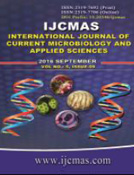


 National Academy of Agricultural Sciences (NAAS)
National Academy of Agricultural Sciences (NAAS)

|
PRINT ISSN : 2319-7692
Online ISSN : 2319-7706 Issues : 12 per year Publisher : Excellent Publishers Email : editorijcmas@gmail.com / submit@ijcmas.com Editor-in-chief: Dr.M.Prakash Index Copernicus ICV 2018: 95.39 NAAS RATING 2020: 5.38 |
PCR amplification of 16S rRNA genes and denaturing gradient gel electrophoresis (DGGE) analysis were used to examine the compositions and dynamics of bacterial communities in the rhizosphere of rice subjected to heavy metal pollution. DGGE showed many common bands under conditions of Cd and Cr pollution, suggesting the presence of similar of bacterial communities. Principal component analysis showed different microbial community structure changes during the study period, for Cd and Cr pollution respectively. Major bands of DGGE patterns were sequenced. Phylogenetic analysis indicated that the majority of the sequences obtained were affiliated with members of Acidobacteria (18.75 %), Myxococcales (12.50 %), Gemmatimonas (12.50 %), and Thiothrix (9.38 %). When the rice plants reached the heading stage, the relative abundance of members of Gemmatimon as increased with Cd concentration, while abundance of members of Gallionellaceae increased with Cr concentration. At the maturation stage, the relative abundance of members of Chlorobiales increased with Cd concentration. These results illuminate the effect on diversity of heavy metal pollution in soil. Further study of combinations of other environmental parameters will clarify heavy metal effects on the activity of microbial communities in rice paddy fields.
 |
 |
 |
 |
 |